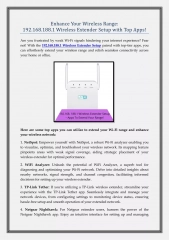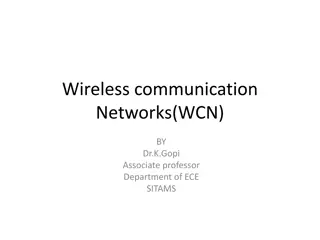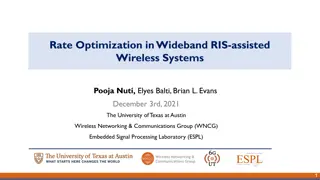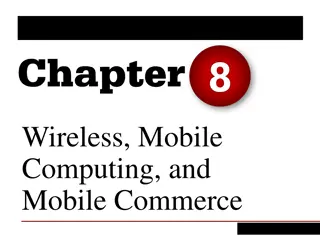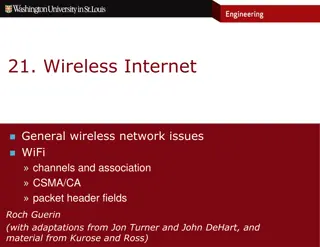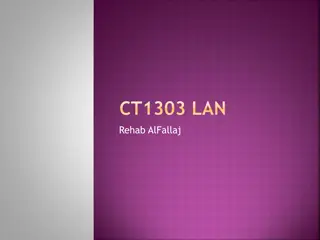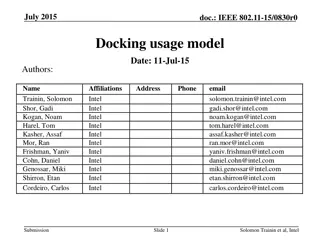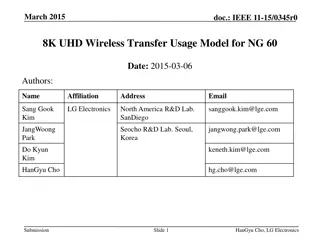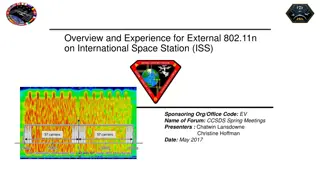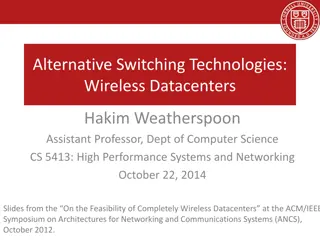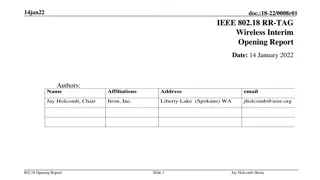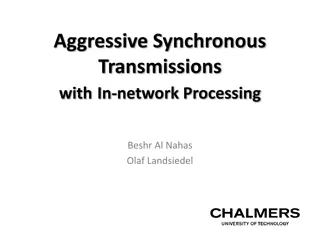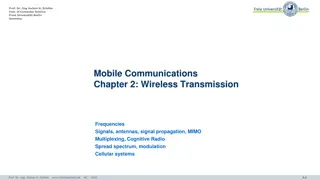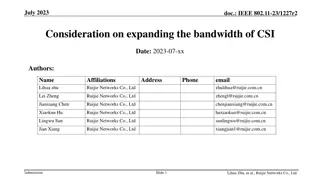Global Wireless Standards Overview
Global Wireless Standards Overview discusses various wireless standards and protocols, including IEEE 802 family standards, Wireless LAN Protocols, and MACA (Multiple Access with Collision Avoidance). It covers topics such as Wireless LAN protocols, IEEE 802 standards, LAN standards, and the encoding techniques used in 802.3 LAN standards. The content delves into the details of different wireless platforms, multiple access issues, and collision avoidance techniques in wireless communication. It provides valuable insights into the world of wireless communications technologies.
Download Presentation

Please find below an Image/Link to download the presentation.
The content on the website is provided AS IS for your information and personal use only. It may not be sold, licensed, or shared on other websites without obtaining consent from the author.If you encounter any issues during the download, it is possible that the publisher has removed the file from their server.
You are allowed to download the files provided on this website for personal or commercial use, subject to the condition that they are used lawfully. All files are the property of their respective owners.
The content on the website is provided AS IS for your information and personal use only. It may not be sold, licensed, or shared on other websites without obtaining consent from the author.
E N D
Presentation Transcript
Wireless LAN Protocols Wireless protocols are inherently multiple access ! Can we use sensing ? What matters is collision at Rx Hidden station problem: C can not sense A. If both target B, there will be a collision Exposed station problem: B sends to A. C senses the medium and concludes that there is activity. So, it does not send to D. The link between C and D is not susceptible to the conversation of A and B. 4
Wireless LAN Protocols MACA: Multiple Access with Collision Avoidance Sender: sends RTS (request to send) Receiver: sends CTS (clear to send) RTS and CTS contain length of message to be sent Key observations: Any station hearing RTS must keep silent during the next phase of data transmission Any station hearing CTS must keep silent during next message 5
IEEE 802 standards IEEE 802 refers to a family of IEEE standards dealing with local area networks and metropolitan area networks: IEEE 802: Overview & Architecture IEEE 802.1 Bridging & Management IEEE 802.2: Logical Link Control IEEE 802.3: CSMA/CD Access Method (Ethernet) IEEE 802.5: Token Ring Access Method IEEE 802.11: Wireless Local Area Networks (LAN) IEEE 802.15: Wireless Personal Area Networks (PAN) IEEE 802.16: Broadband Wireless Metropolitan Area Networks (MAN) IEEE 802.17: Resilient Packet Rings (RPR) IEEE 802.20: Mobile Broadband Wireless Access IEEE 802.21: Media Independent Handoff IEEE 802.22: Wireless Regional Area Network IEEE 802.23: Emergency Services Working Group 6
IEEE standard 802 for LANs 802.3 Ethernet Whole family of 1-persistent CSMA/CD protocols Original design for 1-10 Mbps Various media, first used on 50 ohm coaxial cable Started as ALOHA system on Hawaiian Islands Carrier sensing was added by Xerox 7
802.3 LAN Standard 802.3 Encoding Needed: unambiguously determine start, end and middle of each bit without reference to external clock Two encoding techniques Manchester encoding 1: 1-0 transition 0: 0-1 transition Every bit has transition in the middle. However, twice the bandwidth capacity needed ! Differential encoding 802.3 uses Manchester, +/- 0.85 volt signalling 802.3 Framing Preamble: 7 x 1010.1010 pattern creates 10 MHz square wave of 5.6 microsecond for synchronization Start field: 1010.1011 denotes start of frame 8
802.3 Framing Length field:0-1500 bytes Data:payload Pad: ensure minimum frame length = 64 bytes.needed for collision detection (LAN, 2500 meter, 10 Mbps, 4 repeaters: 51.2 microseconds minimum frame length => 64 bytes) Jam Signal: When a collision is detected during a frame transmission is immediately. A station noting a collision has occurred sends a 4 to 6 byte long pattern composed combinations. The purpose of this is to ensure that any other nodes which may currently be receiving a frame will receive the jam signal in place of the correct 32-bit MAC CRC, this causes the other receivers to discard the frame due to a CRC error of 16 1-0 bit transmission, not the terminated 9
802.3 LAN Standard 802.3 Addressing Addressing: 6 bytes addresses that are assigned by IEEE Bit 47 46 45 0 type of address 0 0 ordinary local 0 1 ordinary global 1 0 group local 1 1 group global 1 1 1 ..1 broadcast Binary Exponential Back off After collision wait 0 or more slots (of 51.2 msec) First collision: wait 0 or 1 slot (choose randomly) Second collision: wait 0, 1, 2 or 3 slots N-th collision: wait 0 (2N-1) slots N max = 10 => wait between 0 - 1023 slots Give up after 16 trials and leave recovery to higher layers Algorithm ensures low latency at low load and fairly resolves collisions when the load is high. 10

 undefined
undefined











